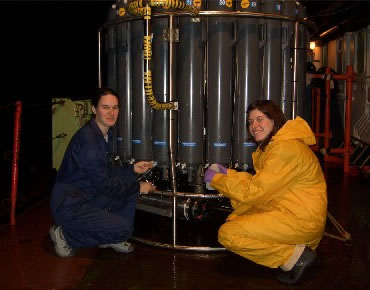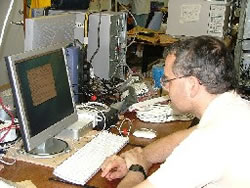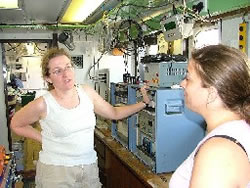

It is now the last week of the cruise and all acquisition and analysis systems continue to run well. CTD station 122 has just been completed. The good weather to which we had become accustomed broke at the beginning of the week. The wind rose and the swell grew. The increased sea state slowed our progress between stations but did not affect our capacity to complete those stations. The weather is better now, the sea is very calm and the sun is even trying to break through the clouds. Everyone is gearing up for the final push as we head towards the closely spaced stations on the continental shelf and on towards Lisbon and home.
We spent this morning in the Azores collecting supplies for the rest of the trip and we are currently steaming back towards the section. We will arrive on station in a few hours and complete the one hundredth station before the end of the day. Before we broke off the section yesterday we were sampling down the eastern flank of the mid Atlantic Ridge and heading towards the Madeira Abyssal Plain. The bottom water that we sampled in 4000 meters of water had the lowest CFCs that we have yet seen on the section and we anticipate seeing even lower values in the bottom of the Basin. The signature of Mediterranean Water has been evident in almost every parameter that we are measuring at about 1000m and since about 40W. This signal intensifies daily as we head closer to the water's source and the end of the section. Elaine
This week we passed through the midway point of our 45-day cruise. Sampling, analysis and data processing are proceeding well. The weather continues to be favourable for our work and we are currently completing our 75th CTD Station. We are at 40W now and will spend the next few days climbing the western flank of the Mid Atlantic Ridge - then it is (almost) down hill all the way to Lisbon...Elaine McDonagh
Since leaving the western boundary we have had a run of good weather which has meant that sampling has run closer to that planned. So far the weather has been calm enough to reach the bottom on the deep stations. I am planning to do my full depth He_Tr station tomorrow after the SAPS which should be in water of about 5000m.
What is also good is that enough data has now been processed to produce sections
so far. Although there are some problems with the bottle oxygens the rest
(temperature, salinity, CTD oxygen, nitrate) look very reasonable. The pictures
Elaine and Paula have produced of the surface current also look good with
a very well defined Gulf Stream on both boundary crossings. Susan Leadbetter
We are approaching our 56th Station. When we arrive, SAPs (stand alone pumping systems) will be deployed at 50m, 100m, and 150m where they will pump water through filters for two hours. The filter papers are stored for analysis of pigments and nitrogen 15 isotopes. Following the SAPs the CTD will be deployed. The sun is shining and the sea is calm. The good conditions are helping us to easily execute stations in over 5000m of water without resorting to a more heavy-duty cable. Long may it continue...Elaine McDonagh.

Ute Schuster
Weather is still mixed but at least it hasn't interrupted any more days of sampling. The more recent He-Tr stations have gone more smoothly now we have had more practice at taking the samples. It looks from the ADCP plots that we managed to put a He_Tr staion in the Western Boundary Current and we definitely managed to get a station in the Gulf Stream on our second crossing of the boundary current. Susan.
Things are better on the ship now. The weather has definitely improved, but a bit choppy again today.
Hope everything is well back on lovely land. Please say hi to everyone from me. Rhiannon.

Susan Leadbetter (left) and Rhiannon Mather (right)
taking samples of water on the RRS Darwin.
The sampling of the first crossing of the Gulf Stream has been completed, but for the last 36 hours no sampling has been done due to bad weather.

We are currently at our tenth sampling station at 37N, 71W, half way across the first of the two sections that will sample the Gulf Stream. We are in a quandary, unsure of whether we are sitting in a cold-core ring shed from the boundary current or whether yesterday's observations of a 2m/s northeastward flow were some of the most easterly observations ever made of the Gulf Stream at this latitude. Our question will be answered in the next few hours - either the sea surface temperature will rise as we pass out of the ring or we have already passed through the Gulf Stream and the temperature will remain depressed. We sailed on Sunday May 1st and left behind the Bermudan sunshine for some stormier weather. It took some of us a while to remember where we had packed our sea legs. Mobilisation had been very successful and St. George (Bermuda's historic town that is twinned with Lyme Regis, Dorset) was deemed to be a charming place to mobilise and do our last minute shopping. Everything is now spun-up. We are busy looking at and processing the data that comes on board as well as taking and analysing (or preparing for storage and analysis on shore) a range of samples for a suite of chemical tracers. Working watches allows the science to run twenty-four hours a day. Elaine McDonagh
